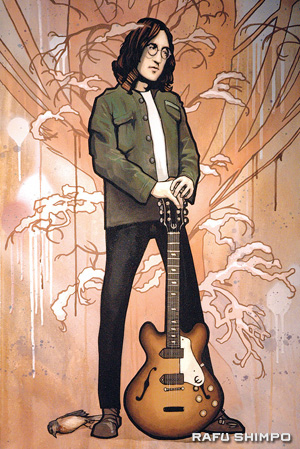Friday, February 11, 2005
September 3, 2009
Fame, Examined from Within
Mike Shinoda’s second “Glorious Excess” chapter displays more potency in message and execution.
By MICHAEL HIRANO CULROSS
Rafu Arts & Entertainment Editor
===
If Mike Shinoda’s exhibition at the Japanese American National Museum last year was a debut of sorts for the musician’s art, then the 2009 continuation of that thread–now at JANM–reveals an undeniably skilled artist who just happens to make music for a living.
It’s hardly unfair to opine that if not for his fame as a member of the band Linkin Park, Shinoda may never have been able to make such a grand splash on the art scene. But in “Glorious Excess (Dies),” the 32-year-old is revealed as a painter of considerable talent and vision, with a profound awareness of several media forms.
Shinoda’s new collection, at JANM through Oct. 4, continues the story that began with his 2008 work, “Glorious Excess (Born),”of a fictitious, skull-headed character who is consumed–literally–by his own stardom. It examines the public’s obsession with celebrities, its voracious appetite for news about famous people and the belief that a life filled with excesses is somehow the mark of success.
Viewers are initially met by the tentacles of an all encompassing monstrous creature, whose outer skin is comprised of lurid clippings from tabloid magazines. As with his earlier show, Shinoda makes a statement about the pervasiveness of “celebrity news,” which has exploded in its prominence, even over the course of the last several months. The web site TMZ approached the status of legitimate news sources this summer by being at the forefront of information on the death of Michael Jackson.
Shinoda, who last year said that such reporting has jumped out of it’s niche to places it doesn’t belong, hasn’t merely launched an indictment of the media with his new exhibit.
Rather, he has the vantage point as an observer who is within the world that all these media outlets clamor to exploit.
The celebrity in focus in “Glorious Excess (Dies)” operates in a world where there are no sensible limits of wealth, sex or violence, and everything is for sale. A four-panel series titled “Oyakodon”–referring to the Japanese dish of chicken and egg–depicts our star with his family, with the young child harnessed in some kind of concealing, protective respirator helmet that bears a Louis Vuitton logo. An inference to Jackson’s son “Blanket” may be inevitable.
One of the four panels of “Oyakodon,” depicts the fictitious star along with his image-conscious family.
Leading a group on a private tour through the exhibit, Shinoda was candid in offering comments on each piece. Media coverage of events that glorify fame–or the destruction thereof–figure more heavily into this collection than last year’s.
“It was my focus,” Shinoda explained. “The show kind of told me where to go. Whatever was in the news, whatever I was watching or getting excited about or turned off by, was what ended up happening for the character.”
The exhibit includes a number of quotes, including Neil Young’s famous line about how it’ is better to burn out than to fade away.
“That is the classic rock and roll excess quote, at least in my book,” Shinoda said.
Perhaps a bit of irony lay in the fact that there was a somewhat star-studded gala held Saturday night for the opening of “Glorious Excess.”
More than 1,000 attended, with the list of celebrities including Lisa Ling and her sister, Laura, recently released from her high-profile imprisonment in North Korea. Shinoda said he was humbled and flattered that she would take the time to stop by.
All of the pieces in the exhibit have been donated to JANM or are for sale through Music For Relief, a charity Shinoda helped establish to assist those affected by disasters, including residents displaced by the recent local wildfires. Some of the profits will go to fund his scholarship at the Art Center College of Design.
Also, in the JANM foyer is a Honda motorcycle, decorated by Shinoda up for auction to benefit the museum. Bids can be placed on eBay through Saturday, with the bids starting at $18,000.
Shinoda doesn’t need to paint; he makes a comfortable living as a member of Linkin Park. But his desire to spend time with a brush–and the joy he takes in it–is on display here as much as his intended theme.
Four canvases in particular stand out as evidence; the four seasons, posthumously embodied by Andy Warhol, Kurt Cobain, James Dean and John Lennon. In color, composition and impact, these stand out from the other works in the installation as the finest, most disciplined pieces of the exhibit.
“Winter (Lennon)” is one of a set of inspired four seasons portraits.
“I kind of don’t [need to paint,] but I kind of do,” Shinoda said. “I really enjoy painting and I end up spending some of my free time doing it. People would be surprised, I actually find time to paint and to just chill out and spend time with my family.
The difference for me where my time is spent and that it’s focused time. I’m not just sitting and watching TV and commercials or reading stuff that makes me feel like I’ve just turned my brain off.”
====
Glorious Excess (Dies) runs through Oct. 4 at the Japanese American National Museum, 369 E. First Street in Little Tokyo. (213) 625-0414 or visit www.janm.org. More information on merchandise related to the exhibit can be found at www.mikeshinoda.com.













0 comments:
Post a Comment